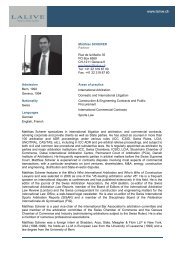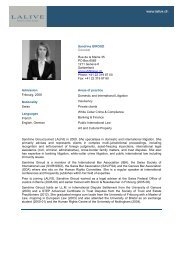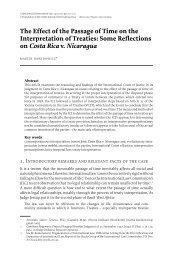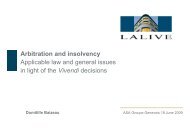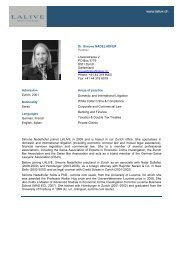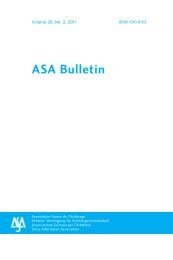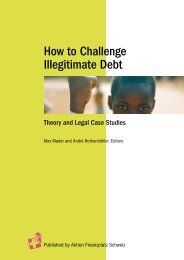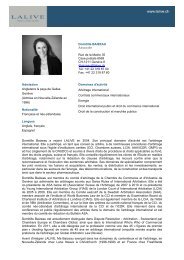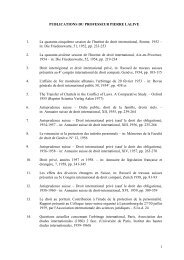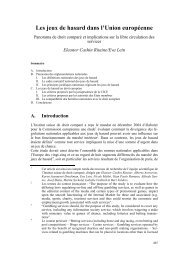Les modes alternatifs de règlement des différends dans le ... - Lalive
Les modes alternatifs de règlement des différends dans le ... - Lalive
Les modes alternatifs de règlement des différends dans le ... - Lalive
Create successful ePaper yourself
Turn your PDF publications into a flip-book with our unique Google optimized e-Paper software.
<strong>Les</strong> <strong>mo<strong>de</strong>s</strong> altérnatifs <strong>de</strong> <strong>règ<strong>le</strong>ment</strong> <strong>de</strong>s <strong>différends</strong> <strong>dans</strong> <strong>le</strong> domaine <strong>de</strong> la construction 271<br />
et commercia<strong>le</strong>, qui a pour objet <strong>de</strong> « faciliter la reconnaissance et d'instaurer une procédure<br />
rapi<strong>de</strong> afin d'assurer l'exécution <strong>de</strong>s décisions, <strong>de</strong>s actes authentiques et <strong>de</strong>s transactions<br />
judiciaires »).<br />
Le contraste entre l’extraordinaire bienveillance témoignée par la communauté <strong>de</strong>s nations à<br />
l’égard <strong>de</strong>s tribunaux arbitraux privés et la réserve, voire la méfiance, affichée et persistante à<br />
l’égard <strong>de</strong>s autorités judiciaires d’Etats tiers est saisissant. Il est en règ<strong>le</strong> généra<strong>le</strong> plus faci<strong>le</strong> <strong>de</strong><br />
faire exécuter une sentence arbitra<strong>le</strong> rendue en Europe aux Etats-Unis, par application <strong>de</strong> la<br />
Convention <strong>de</strong> New York, qu’un jugement d’un tribunal étatique européen. La nouvel<strong>le</strong><br />
Convention <strong>de</strong> la Haye du 30 juin 2005 sur <strong>le</strong>s accords d’é<strong>le</strong>ction <strong>de</strong> for a essayé <strong>de</strong> promouvoir<br />
un traité international permettant l’exécution d’un jugement rendu <strong>dans</strong> un pays membre <strong>dans</strong><br />
<strong>le</strong>s autres Etats signataires, mais en vain.<br />
<strong>Les</strong> parties sont libres <strong>de</strong> choisir <strong>le</strong>s règ<strong>le</strong>s <strong>de</strong> procédure applicab<strong>le</strong>s à la conduite <strong>de</strong> la<br />
procédure arbitra<strong>le</strong>, <strong>dans</strong> <strong>le</strong>s limites du droit applicab<strong>le</strong> au siège du tribunal arbitral. Ainsi, tout<br />
arbitrage international ayant son siège en Suisse est soumis au Chapitre 12 <strong>de</strong> la Loi sur <strong>le</strong> droit<br />
international privé (LDIP), la <strong>le</strong>x arbitri (« loi <strong>de</strong> l’arbitrage » en latin). De la même manière,<br />
tout arbitrage <strong>de</strong> droit interne suisse est régi par <strong>le</strong> Concordat intercantonal sur l'arbitrage,<br />
adopté par la conférence <strong>de</strong>s directeurs cantonaux <strong>de</strong> la justice <strong>le</strong> 27 mars 1969 et approuvé par<br />
<strong>le</strong> Conseil fédéral <strong>le</strong> 27 août 1969. Ces textes contiennent <strong>de</strong>s règ<strong>le</strong>s <strong>de</strong> procédure généra<strong>le</strong>s. Si<br />
<strong>le</strong>s parties souhaitent <strong>de</strong>s règ<strong>le</strong>s plus élaborées, el<strong>le</strong>s sont libres <strong>de</strong> <strong>le</strong>s rédiger el<strong>le</strong>s-mêmes,<br />
d’adopter <strong>le</strong>s règ<strong>le</strong>s <strong>de</strong> procédures proposées par la Conférence <strong>de</strong>s Nations Unis pour <strong>le</strong> droit<br />
commercial international (CNUDCI) 15 ou <strong>de</strong> confier cette tache aux arbitres. <strong>Les</strong> parties ont<br />
éga<strong>le</strong>ment la possibilité <strong>de</strong> soumettre <strong>le</strong> litige à un arbitrage administré par une institution<br />
spécialisée, en adoptant son <strong>règ<strong>le</strong>ment</strong> d’arbitrage.<br />
<strong>Les</strong> institutions d’arbitrage <strong>le</strong>s plus connues sont la Cour d’arbitrage international <strong>de</strong> la<br />
Chambre <strong>de</strong> commerce international (CCI), située à Paris, qui administre <strong>de</strong>s arbitrages partout<br />
<strong>dans</strong> <strong>le</strong> mon<strong>de</strong>.<br />
<strong>Les</strong> « Swiss Ru<strong>le</strong>s of International Arbitration » ont été conçues et adoptées par <strong>le</strong>s six plus<br />
importantes chambres <strong>de</strong> commerce en Suisse (soit, Bâ<strong>le</strong>, Berne, Genève, Tessin, Vaud et<br />
Zurich). El<strong>le</strong>s constituent un <strong>règ<strong>le</strong>ment</strong> d’arbitrage international uniforme et ont été adoptées en<br />
2004. <strong>Les</strong> autres institutions d’arbitrage <strong>le</strong>s plus connues comprennent notamment la London<br />
Court of International Arbitration (LCIA), <strong>le</strong> Règ<strong>le</strong>ment d’arbitrage <strong>de</strong> l’Institut d’Arbitrage <strong>de</strong><br />
la Chambre <strong>de</strong> Commerce <strong>de</strong> Stockholm; l’Association d’Arbitrage Américaine (AAA) et sa<br />
branche internationa<strong>le</strong>, <strong>le</strong> International Centre for Dispute Resolution (CEDR). En Asie on songera<br />
notamment à la China Economic and Tra<strong>de</strong> Arbitration Commission (CIETAC), au Singapore<br />
International Arbitration Centre (SIAC) et au Hong Kong International Arbitration Centre<br />
(HKIA). Un centre d’arbitrage qui a connu un succès fulgurant ces <strong>de</strong>rnières années est <strong>le</strong><br />
Centre international pour <strong>le</strong> <strong>règ<strong>le</strong>ment</strong> <strong>de</strong>s <strong>différends</strong> relatifs aux investissements (CIRDI 16 ). Le<br />
CIRDI est une institution spécialisée, qui a sa source <strong>dans</strong> la Convention <strong>de</strong> Washington <strong>de</strong>1965<br />
pour <strong>le</strong> <strong>règ<strong>le</strong>ment</strong> <strong>de</strong>s <strong>différends</strong> relatifs aux investisseurs entre Etats et ressortissants d’autres<br />
Etats, à laquel<strong>le</strong> la plupart <strong>de</strong>s pays ont adhéré. El<strong>le</strong> permet à un investisseur d’un Etat signataire<br />
d’instituer unilatéra<strong>le</strong>ment une procédure arbitra<strong>le</strong> à l’encontre <strong>de</strong> l’Etat hôte <strong>de</strong><br />
l’investissement s’il a donné son consentement à l’arbitrage CIRDI <strong>dans</strong> un contrat<br />
d’investissement ou <strong>dans</strong> un traité bilatéral d’investissement (TBI ou « BIT » en anglais 17 ) et<br />
manque à ses engagements contractuels ou internationaux.<br />
15<br />
Règ<strong>le</strong>ment d’arbitrage <strong>de</strong> la CNUDCI, acronyme pour Commission <strong>de</strong>s Nations Unies pour <strong>le</strong> droit commercial<br />
international (UNCITRAL en anglais).<br />
16<br />
ICSID <strong>de</strong> son nom anglais.<br />
17<br />
En résumé, un TBI accor<strong>de</strong> un certain <strong>de</strong>gré <strong>de</strong> protection aux investisseurs étrangers qui ont réalisé un<br />
investissement au sein du pays d’accueil <strong>de</strong> l’investissement et interdit à ce <strong>de</strong>rnier <strong>de</strong> discriminer, d’exproprier sans<br />
compensation ou <strong>de</strong> spolier l’investisseur étranger.<br />
JDC 2007



